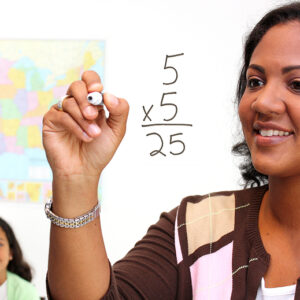I am the parent of two children and an associate professor of math education. Like all parents, my husband and I scramble to figure out how to do our jobs, plus care for and educate our children. As a math educator, I know data indicate school math learning progress of most students has been adversely affected by the pandemic. However, this problem can also be an opportunity to tackle imperfections of traditional ways of engaging kids in math.
“Improvement science” can drive organizational change during great challenges. I’ve witnessed this while collaborating with Toyota and the Dallas Independent School District to design the West Dallas STEM School (opening this fall) and while participating in a Networked Improvement Community of Texas universities, dedicated to improving teacher preparation across the state.
We learned from Toyota and the Carnegie Foundation to stop and consider the root causes of our present challenge, math learning loss, before assigning temporary solutions to weather the pandemic. Taking this step is difficult because it requires extra effort, time, commitment, and resources — and I can tell you that what I really want as a parent in this pandemic is a quick solution. However, a quick solution is often not the best solution.
COVID-19 is not necessarily the root cause of learning loss. It has instead compounded and highlighted other systemic root causes — in particular, the ways kids experience mathematics in schools and the way society treats math as something only a select few can do. The system encourages us to teach math as a set of disjointed topics that need to be covered, often taught with an “I do, we do, you do” instructional structure.
This model limits students’ development of conceptual understanding. Instead of being taught a new set of procedures to master, students need to wrestle with how new ideas fit with things they already understand. When doing so, students learn everyone is capable of math — and, in fact, practices it daily. Even before COVID-19, our mathematics education system was not serving most kids. Some just assumed they didn’t “get” math; others never really understood the mathematics they were taught in school, and this manifested when they had to enroll in college remedial math courses.
Students, parents, and educators can implement strategies to lessen the impact of math learning loss. Parents: do math together and highlight the mathematics already present in day-to-day routines, such a counting out placemats or table settings at home. Teachers: present practical problems to students who can solve them with math. District and state leaders: remove the pressure of state testing, and reevaluate educational priorities so they reflect what it is we want students to know and do — rather than doing what we have always done.
We read to children, why not do math with them? Use the internet, cell phone, or library access to incorporate the strategies.
Parents should listen as kids wonder about quantities or mathematical objects and ask follow-up questions that encourage them to explain their thinking. Sample ideas to do this on this website, or search #tmwyk on Twitter. You can look to WalkSTEM to get ideas for how to see math in Dallas and watch related videos with your kids about places they recognize.
Play math games or (or board games): Favorites are “Tiny Polka Dot” and “Prime Climb” from Math for Love. Read books to your kids that involve mathematical ideas: https://dreme.stanford.edu/news/children-s-books-foster-love-math.
Teachers and principals should help students see math in their world and foster their enjoyment. Try #mtbos community on Twitter. Engaging in number talks, open middle mathematics problems, three-act math tasks, and investigations on the Desmos online graphing calculator.
District/State leaders and researchers need to identify priority outcomes and key concepts, adjust curriculum and standards to allow for deep exploration of those key concepts and connections to students’ out-of-school lives, and reduce the emphasis on testing.
The pandemic is stressing our societal systems and has forced parents to become more actively involved in their children’s education, which places new challenges and stresses on family life. We can mitigate math learning loss associated with this interruption in our lives, not with quick fixes, but by integrating math into our daily lives and implementing sound long-term strategies.

